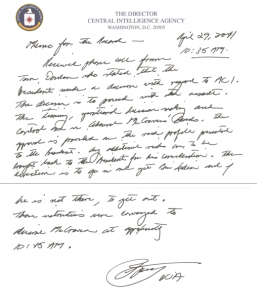Peter Bergen’s Bumper Sticker
 Yesterday, just two days after the unofficial start of the General Election, Joe Biden officially rolled out the slogan he had already warned would be his refrain for the entire campaign season:
Yesterday, just two days after the unofficial start of the General Election, Joe Biden officially rolled out the slogan he had already warned would be his refrain for the entire campaign season:
If you’re looking for a bumper sticker to sum up how President Obama has handled what we inherited, it’s pretty simple: Osama bin Laden is dead and General Motors is alive.
Also yesterday, Time Magazine rolled out a Peter Bergen article, The Last Days of Osama Bin Laden (which is still behind the paywall), accompanied not just by a bunch of other piggy-backed articles, but the letter above, Leon Panetta’s record of National Security Advisor Tom Donilon’s call telling him the operation against OBL was a go.
I guess we’re supposed to assume the timing of the two events is entirely coincidental.
The other event that transpired yesterday–Judge James Boasberg’s order ruling the CIA had properly withheld 52 photos taken during the raid on OBL’s compound under FOIA exemption 1 (properly classified information)–probably was just a coincidence.
But it does remind us that the photos–that is, records of the same covert operation as Leon Panetta’s note recorded–were immediately stamped “Top Secret,” considered derivatively classified, and subsequently formally classified and withheld from FOIA.
And yet, here Panetta’s note is, somehow having evaded the classification stamps. That, in spite of the fact that it records the normally religiously guarded Presidential communications, not to mention details of how CIA and JSOC work together on covert ops, the time it was officially okayed, that McRaven was informed first even though CIA was ostensibly in charge of the op. All of it stuff that, had the op blown up in Obama’s face, would be as carefully guarded as those pictures of OBL’s funeral.
In my mind, this whole festival of information asymmetry targeted at voters is capped off by the byline involved: Peter Bergen.
When I read about the imprisonment of journalists like Abdulelah Haider Shaye, or the wiretapping of Lawrence Wright and Christiane Amanpour, I think back to Bergen, who in the days after 9/11 was an important, reliable source who knew more about al Qaeda than many of the people taxpayers were paying to keep us safe. I’ve always thought, as our government targets journalists covering Islamic extremists, we’re handcuffing the next Peter Bergen, that journalist who is right now collecting the information our intelligence community is neglecting.That Peter Bergen is likely to be imprisoned, like Shaye, for talking directly to a terrorist.
And what has Bergen become, along the way? The outlet for officially leaked information–one more tool in the President’s toolbox of information asymmetry.
I don’t blame the Obama Administration for running on Joe Biden’s pithy slogan. But I do blame it for corrupting information in this way, both the system of classification that should be free from politics, and the space it accorded journalists to do their job when the government wasn’t.
Update: See this for details of how Brian Williams will film Obama and friends re-enacting last year’s Sit Room drama as they killed OBL.
Update: One of the things Judicial Watch complained about in their OBL suit is that the photos were probably classified only after the government received their FOIA on May 2 (to DOD) and May 4 (to CIA). CIA Information Review Officer Elizabeth Anne Culver explained that the CIA always considered the photos classified.
Contrary to Plaintiff’s suggestion, after their creation these extraordinarily sensitive images were always considered to be classified by the CIA and were consistently maintained in a manner appropriate for their classification level.
So wouldn’t Panetta’s note be considered derivatively classified, just like the photos? If so, why doesn’t have declassification markings now?
